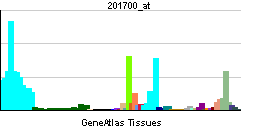| Cyclin D3 | |||||||||||
|---|---|---|---|---|---|---|---|---|---|---|---|
| Identifiers | |||||||||||
| Symbols | CCND3 ; | ||||||||||
| External IDs | Template:OMIM5 Template:MGI HomoloGene: 20419 | ||||||||||
| |||||||||||
| RNA expression pattern | |||||||||||
 | |||||||||||
| More reference expression data | |||||||||||
| Orthologs | |||||||||||
| Template:GNF Ortholog box | |||||||||||
| Species | Human | Mouse | |||||||||
| Entrez | n/a | n/a | |||||||||
| Ensembl | n/a | n/a | |||||||||
| UniProt | n/a | n/a | |||||||||
| RefSeq (mRNA) | n/a | n/a | |||||||||
| RefSeq (protein) | n/a | n/a | |||||||||
| Location (UCSC) | n/a | n/a | |||||||||
| PubMed search | n/a | n/a | |||||||||
Cyclin D3, also known as CCND3, is a human gene.
The protein encoded by this gene belongs to the highly conserved cyclin family, whose members are characterized by a dramatic periodicity in protein abundance through the cell cycle. Cyclins function as regulators of CDK kinases. Different cyclins exhibit distinct expression and degradation patterns which contribute to the temporal coordination of each mitotic event. This cyclin forms a complex with and functions as a regulatory subunit of CDK4 or CDK6, whose activtiy is required for cell cycle G1/S transition. This protein has been shown to interact with and be involved in the phosphorylation of tumor suppressor protein Rb. The CDK4 activity associated with this cyclin was reported to be necessary for cell cycle progression through G2 phase into mitosis after UV radiation.[1]
See also[edit | edit source]
References[edit | edit source]
- Motokura T, Keyomarsi K, Kronenberg HM, Arnold A (1992). "Cloning and characterization of human cyclin D3, a cDNA closely related in sequence to the PRAD1/cyclin D1 proto-oncogene". J. Biol. Chem. 267 (28): 20412–5. PMID 1383201.
- Inaba T, Matsushime H, Valentine M; et al. (1992). "Genomic organization, chromosomal localization, and independent expression of human cyclin D genes". Genomics. 13 (3): 565–74. PMID 1386335.
- Xiong Y, Menninger J, Beach D, Ward DC (1992). "Molecular cloning and chromosomal mapping of CCND genes encoding human D-type cyclins". Genomics. 13 (3): 575–84. PMID 1386336.
- Motokura T, Yi HF, Kronenberg HM; et al. (1992). "Assignment of the human cyclin D3 gene (CCND3) to chromosome 6p----q13". Cytogenet. Cell Genet. 61 (1): 5–7. PMID 1387066.
- Matsuoka S, Yamaguchi M, Matsukage A (1994). "D-type cyclin-binding regions of proliferating cell nuclear antigen". J. Biol. Chem. 269 (15): 11030–6. PMID 7908906.
- Meyerson M, Harlow E (1994). "Identification of G1 kinase activity for cdk6, a novel cyclin D partner". Mol. Cell. Biol. 14 (3): 2077–86. PMID 8114739.
- Dowdy SF, Hinds PW, Louie K; et al. (1993). "Physical interaction of the retinoblastoma protein with human D cyclins". Cell. 73 (3): 499–511. PMID 8490963.
- Brooks AR, Shiffman D, Chan CS; et al. (1996). "Functional analysis of the human cyclin D2 and cyclin D3 promoters". J. Biol. Chem. 271 (15): 9090–9. PMID 8621559.
- Tiefenbrun N, Melamed D, Levy N; et al. (1996). "Alpha interferon suppresses the cyclin D3 and cdc25A genes, leading to a reversible G0-like arrest". Mol. Cell. Biol. 16 (7): 3934–44. PMID 8668211.
- Hirai H, Sherr CJ (1996). "Interaction of D-type cyclins with a novel myb-like transcription factor, DMP1". Mol. Cell. Biol. 16 (11): 6457–67. PMID 8887674.
- Doglioni C, Chiarelli C, Macrí E; et al. (1998). "Cyclin D3 expression in normal, reactive and neoplastic tissues". J. Pathol. 185 (2): 159–66. doi:10.1002/(SICI)1096-9896(199806)185:2<159::AID-PATH73>3.0.CO;2-0. PMID 9713342.
- Gómez Lahoz E, Liegeois NJ, Zhang P; et al. (1999). "Cyclin D- and E-dependent kinases and the p57(KIP2) inhibitor: cooperative interactions in vivo". Mol. Cell. Biol. 19 (1): 353–63. PMID 9858559.
- Gabrielli BG, Sarcevic B, Sinnamon J; et al. (1999). "A cyclin D-Cdk4 activity required for G2 phase cell cycle progression is inhibited in ultraviolet radiation-induced G2 phase delay". J. Biol. Chem. 274 (20): 13961–9. PMID 10318807.
- Zhang Q, Wang X, Wolgemuth DJ (1999). "Developmentally regulated expression of cyclin D3 and its potential in vivo interacting proteins during murine gametogenesis". Endocrinology. 140 (6): 2790–800. PMID 10342870.
- Bartkova J, Rajpert-de Meyts E, Skakkebaek NE, Bartek J (2000). "D-type cyclins in adult human testis and testicular cancer: relation to cell type, proliferation, differentiation, and malignancy". J. Pathol. 187 (5): 573–81. doi:10.1002/(SICI)1096-9896(199904)187:5<573::AID-PATH289>3.0.CO;2-H. PMID 10398124.
- Jones CJ, Kipling D, Morris M; et al. (2000). "Evidence for a telomere-independent "clock" limiting RAS oncogene-driven proliferation of human thyroid epithelial cells". Mol. Cell. Biol. 20 (15): 5690–9. PMID 10891505.
- Sansal I, Dupont E, Toru D; et al. (2000). "NPDC-1, a regulator of neural cell proliferation and differentiation, interacts with E2F-1, reduces its binding to DNA and modulates its transcriptional activity". Oncogene. 19 (43): 5000–9. doi:10.1038/sj.onc.1203843. PMID 11042687.
- Fink JR, LeBien TW (2001). "Novel expression of cyclin-dependent kinase inhibitors in human B-cell precursors". Exp. Hematol. 29 (4): 490–8. PMID 11301189.
- Lin J, Jinno S, Okayama H (2001). "Cdk6-cyclin D3 complex evades inhibition by inhibitor proteins and uniquely controls cell's proliferation competence". Oncogene. 20 (16): 2000–9. doi:10.1038/sj.onc.1204375. PMID 11360184.
- Bartkova J, Thullberg M, Slezak P; et al. (2001). "Aberrant expression of G1-phase cell cycle regulators in flat and exophytic adenomas of the human colon". Gastroenterology. 120 (7): 1680–8. PMID 11375949.
| This protein-related article is a stub. You can help Wikipedia by expanding it. |